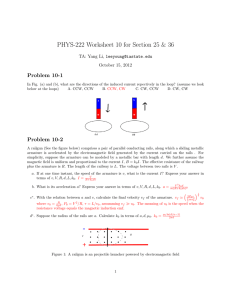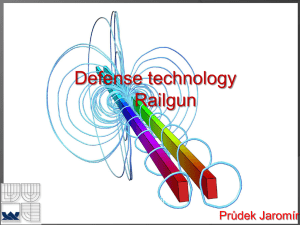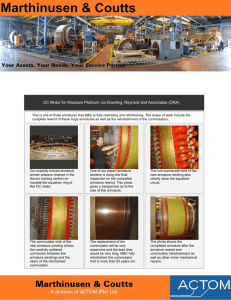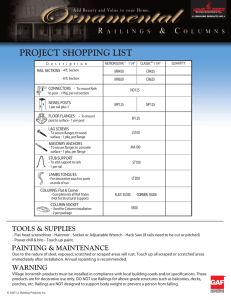Document 13134105
advertisement
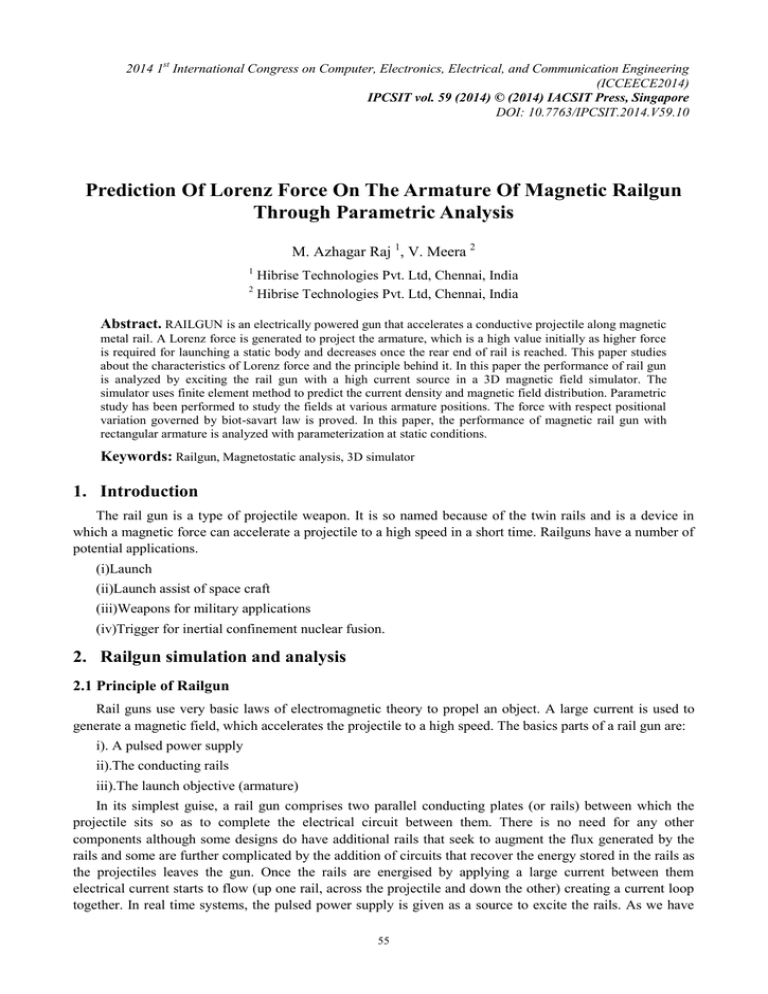
2014 1st International Congress on Computer, Electronics, Electrical, and Communication Engineering (ICCEECE2014) IPCSIT vol. 59 (2014) © (2014) IACSIT Press, Singapore DOI: 10.7763/IPCSIT.2014.V59.10 Prediction Of Lorenz Force On The Armature Of Magnetic Railgun Through Parametric Analysis M. Azhagar Raj 1, V. Meera 2 1 2 Hibrise Technologies Pvt. Ltd, Chennai, India Hibrise Technologies Pvt. Ltd, Chennai, India Abstract. RAILGUN is an electrically powered gun that accelerates a conductive projectile along magnetic metal rail. A Lorenz force is generated to project the armature, which is a high value initially as higher force is required for launching a static body and decreases once the rear end of rail is reached. This paper studies about the characteristics of Lorenz force and the principle behind it. In this paper the performance of rail gun is analyzed by exciting the rail gun with a high current source in a 3D magnetic field simulator. The simulator uses finite element method to predict the current density and magnetic field distribution. Parametric study has been performed to study the fields at various armature positions. The force with respect positional variation governed by biot-savart law is proved. In this paper, the performance of magnetic rail gun with rectangular armature is analyzed with parameterization at static conditions. Keywords: Railgun, Magnetostatic analysis, 3D simulator 1. Introduction The rail gun is a type of projectile weapon. It is so named because of the twin rails and is a device in which a magnetic force can accelerate a projectile to a high speed in a short time. Railguns have a number of potential applications. (i)Launch (ii)Launch assist of space craft (iii)Weapons for military applications (iv)Trigger for inertial confinement nuclear fusion. 2. Railgun simulation and analysis 2.1 Principle of Railgun Rail guns use very basic laws of electromagnetic theory to propel an object. A large current is used to generate a magnetic field, which accelerates the projectile to a high speed. The basics parts of a rail gun are: i). A pulsed power supply ii).The conducting rails iii).The launch objective (armature) In its simplest guise, a rail gun comprises two parallel conducting plates (or rails) between which the projectile sits so as to complete the electrical circuit between them. There is no need for any other components although some designs do have additional rails that seek to augment the flux generated by the rails and some are further complicated by the addition of circuits that recover the energy stored in the rails as the projectiles leaves the gun. Once the rails are energised by applying a large current between them electrical current starts to flow (up one rail, across the projectile and down the other) creating a current loop together. In real time systems, the pulsed power supply is given as a source to excite the rails. As we have 55 performed static analysis a current source of 300 kA has been used to excite the rail for simulation purposes [2]. The railgun modelled in the simulator is shown in fig 1. . Fig 1. The Railgun model Fig 2. The current conduction path in railgun A railgun is a device which uses electrical current to take advantage of Laplace forces and the BiotSavart law in order to launch a projectile. The following illustration shows the physics behind rail gun operation. The magnetic field is produced by the current running through the rails and armature. The current i produces magnetic field B in accordance with the Biot - Savart Law, which says that current flowing through a wire will generate a magnetic field proportional to the current magnitude and inversely proportional to the distance from the wire [3]. If a current-carrying wire or object is placed in a magnetic field, then that wire or object experiences a force. For the rail gun, the object is the armature or projectile seen in Figure. This force is referred to as the Lorenz force given by ̅ ̅ ̅ Where ̅ is the force on the projectile, ̅ is the magnetic field vector, ̅ is the width vector of the armature, and i is the current in the wire (the length vector is in the direction of current flow). This means that the force on the projectile is proportional to the current, the width of the armature, and the magnitude of the magnetic field (assuming ̅ and ̅ are perpendicular).The conduction path of current is given by Fig 2. 2.2 Parametric Analysis The current in the conductors creates a magnetic field which in turn creates a Lorentz force on the projectile causing it to be driven along the rails until it is launched from the end. The Lorenz force developed is studied at different armature positions.8 armature positions are parametrised and the Lorenz force at each position is analysed [4]. The initial position is taken as 10cm and farther most position is taken as 80cm. Meshing of individual units of railgun provides better results and meshing has been provided for the railgun model. The Length based inside selection method has been used for meshing. Maximum number of elements during mesh was 9000. The mesh plot of railgun is given by Fig 3. 56 Fig3.The Mesh plot of railgun. Fig4. The starting, mid and final positions in armature movement The starting, mid and ending positions taken by armature are depicted in the fig 4. The Lorenz force taken at different armature positions is depicted in the Fig 5. TABLE I: Lorenz force (kN) for corresponding armature position (cm) Armature position(cm) Lorenz force(kN) 10 14.60931 20 13.73257 30 13.62537 40 13.61248 50 13.60894 60 13.59503 70 13.51454 80 12.81533 -Fig 5. Plot of Lorenz force(kN) Vs armature position(cm) The tabulation gives the value of Force (kN) Vs armature movement (cm). These results prove the biot savart right. As per biot savart law when current flows through two parallel conductors, the Lorenz force developed within the conductors shown in Fig6, Where Lorenz force (F) is given by Equation (1) proves the Lorenz force is inversely proportional to the distance .The current prefers to take the shortest path to reach the destination railgun. Hence from the plot of Lorenz force Vs armature movement this is evident that the position 10 cm has the highest force value because it is the shortest path for current flow from positive rail to negative rail, in comparison to the longest path at position 80 cm. 57 、 Fig 6.Biot savart law for two parallel current carrying conductors Fig 7. Force (kN) Vs armature position (cm) 2.3. Simulation Results 2.3.1 Current density plot The field plot of current density shows the conduction path of current from positive rail to armature to negative rail. The current of 300 kA is applied to the positive rail. The current density J is in range of 3e+7 to 1.2e+8 A/m2. Fig 8 depicts the current density plot of railgun [1]. Fig 8. Magnitude of current density plot of railgun. Fig 9. Current density plot of railgun The magnitude of current density is depicted in figure 8. The magnitude plot depicts the distribution of current in various regions of railgun. 2.3.2 B field plot The magnitude of B field is given by Fig 10.The field is established in ranges from0.1 T- 1.88 T. The maximum field is available near armature railgun junction. The minimum field is available at the farthest distance from conduction path. The B field vector plot is given by Fig11 58 Fig 10. Magnitude of Bfield for Railgun. Fig 11. B field vector plot of railgun 2.4 Conclusion The railgun have been applied in many critical applications like military weapons where the Lorenz force prediction helps to get improved results, this paper helps in predicting of the force variation in the rail gun at its rear and farther end. The results obtained help in validating the Biot savart law. The pulsed current source is applied as current source in real-time railguns, but for static studies a current source has been used. Hence transient analysis using the pulsed current source has been the path forward, which is discussed in the upcoming paper to be published. 3. Acknowledgements The Authors like to thank Hibrise Technologies for their immense support and for providing the necessary resources for completion of paper. Special Thanks to Almighty for his grace. 4. References [1] Paul J Cote, Mark A. Johnson, and Krystyna Truszkowska,” Role of Induced Fields in Railguns”, Excerpt from the Proceedings of the COMSOL Users Conference 2006 Boston [2] D. A. Weeks, W. F. Weldon and R. C. Zowarka, Jr., “ plasma armature railgun launcher simulations at the university of texas at Austin” Fourth Symposium on Electromagnetic Launch Technology, Austin, IEEE Transactions on Magnetics, vol. 25, no. 1, January1989, pp. 580-586. [3] “Design of a Rail Type Electromagnetic Launcher”, IEEE Paper Competition 2012,page:1-13 [4] Asghar Keshtkar, Toraj Maleki and Ahmad Keshtkar,”Determination of Optimum Rails Dimensions in Railgun by Lagrange’s Equations”, IEEE transactions on magnetics, vol. 45, no. 1, 2009, page: 594-598. Azhagar Raj holds a M.E., in Power Electronics and Drives from Anna University and B.E., in Electrical and Electronics from University of Madras. His field of expertise include electromagnets, motors, sensors, generators, actuators and automatic control. He has been issued US patents for his research work. He has career focused manufacturing engineering at some of the premier companies like General Electric (GE), Honeywell and Suzlon. He has developed tools for motor and sensor design for different applications. He also has extensive international experience in working with America, Europe, Asia. Author’s formal Author’s formal photo V. Meera holds a B.E in Electronics and Instrumentation from Kamaraj college of Engineering, Virudhungar, by 2011 and M.E in Power electronics and drives from SSN College, Kalavakkam, by 2013. She currently works as a Design Engineer at Hibrise Technologies. Her research interests include Motor design, Sensors, Power electronics, Electromagnetics and electromechanical devices. 59
